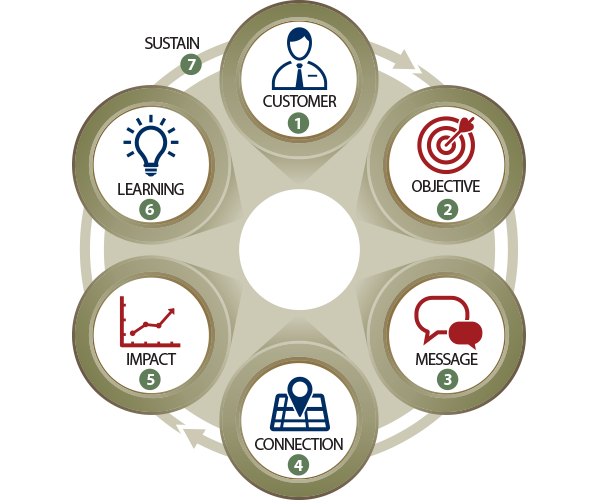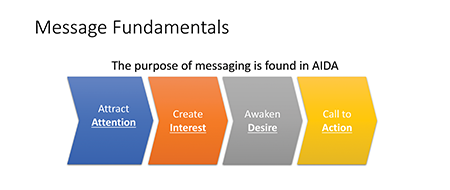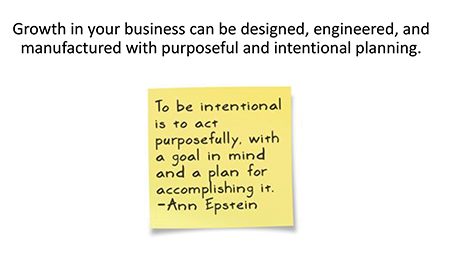Manufacturers have spent the last couple decades using lean and ISO to improve the productivity of their operations. Many of them are now turning their attention outward, and finding ways to climb and to grow and expand. The purpose of this article is to demonstrate that growth can be designed.
In 2016, Enterprise Minnesota used the State of Manufacturing®, its comprehensive annual survey of Minnesota’s manufacturers, to ask how executives view revenue growth. When asked to name the most significant future drivers of growth, for example, most manufacturers said “new customers.” In a related response, only 40 percent said their company chases growth through a formal strategic plan; a little more than 60 percent said they didn’t, or worse (from my point of view), weren’t sure.

To me, the operative takeaway from those State of Manufacturing questions is whether the plan is formal. The fact is, no matter how they answered, all companies have some plan for growth, otherwise they wouldn’t be in business. The operative question is “How formal is it?” By that I mean, is it documented? Is it communicated? Is it summarized on a poster somewhere in the building? Is it a regular component in employee meetings?
In my opinion, the more formal the better. In order to effectively grow through new customers, I believe you need to have a strategy or plan. The reason is that a strategic plan guides and directs what you do. It gives purpose to your action. There is a quote from Sun Tzu that describes the relationship between strategy and tactics (or action). “Strategy without tactics is the slowest route to victory,” he says. “Tactics without strategy is the noise before defeat.” It is important to have both, yet there is a clear order. Strategy gives birth to and directs our tactics and action.
With that said, a strategy or plan to grow your business and customer base should include a way to connect with and influence those customers. And, this isn’t just for new customers. This could be also with existing customers. So the question is, how can I connect with, and how can I influence new or existing customers to partner and do business with me? Taking a deliberate or purposeful approach in connecting with and influencing customers will increase your effectiveness of growing with them.
Ok, but how do I do that? In the same way that we use processes to drive purposeful action and results in our operations, we can use a process to connect with and influence customers to grow our businesses. This brings us to the Seven Steps for Revenue Growth. This is a process that we use at Enterprise Minnesota to take purposeful action towards growth in your business. It is a process that can be used to design and execute the actions that support your strategy.

Step 1
Identify and understand your customers
They aren’t all the same.
The better we understand our customers, the more effectively we’ll pursue their business. To increase understanding, I always operate from two assumptions about customers that aren’t as elementary as they might appear: First, customers are different, and second, customers have choices. Here’s what I mean:
Many manufacturers think “all my customers are the same.” It’s true that many customers share similarities, but recognizing their differences is where profitable long-term relationships are born. Some obvious differences are things like their industry, size, business model, or regulatory requirements. Some of the more subtle differences lie in their approach to business and relationships. Maybe they focus on price, delivery, exceptional quality, customer service or ease of doing business. It goes without saying that all customers want all those things, to be sure, but they inevitably prioritize one over the others. When we more fully understand these differences, we enable ourselves to connect with new prospects in a more relevant and meaningful way because ultimately, those differences influence what our customers care about, which drives their choices.
When it comes to choice, we often think that the power of choice resides with the customer. They make binary choices every day between product A and B or service C and D. With that in mind, we strive to ensure our product or service is better than our competitors. However, the power of choice does not end there. As providers of products and services, we also have the power to choose and our choices look different. It is not whether to serve this customer or that but rather what mix of customer profiles best suit the products, services and profit potential of our business. Another way to think of it is which customers perceive the most value in the products and services we offer? For example, If I produce round holes, I want to pursue customers that have round pegs because I know that the perception and transfer of value goes both ways. What I don’t want to do is invest my scarce resources in the pursuit of square peg customers because I know there is not good value in either direction. What this means is that we want to prioritize and pursue those best fit customers which will maximize the result of our growth efforts.
Step 2
Establish objectives
Specific targets provide focus and direction
Now that we know our target customer(s), we can establish our business objective. The power of doing this is that it provides focus and direction; it establishes boundaries and reduces distractions. In fact, the more narrowly we define our objective, the more likely we are to really get the results we are looking for. Plus, if your entire management team is focused on the pursuit of well-designed objectives, they (or you!) are less likely to get distracted by the shiny objects that appear along the way.
One way to create your objective is by answering a few basic questions. What are you trying to accomplish? What results are you looking for? Is it an increase in sales? More brand awareness? Breaking into a new industry? You can also ask some more focused and customer-oriented questions. What do you want the customers to do? How can you influence them towards action? Then drill deeper. What action do you want customers to take? Do you want them to call, email or visit your tradeshow booth? If that’s it, what are you doing to get that accomplished?
With the objective set, the next step is to strengthen it by making it SMART: specific, measurable, attainable, relevant, and time-bound. SMART objectives bring clarity to what needs to happen and when. It is easy to know when it is accomplished. For example, let’s say your objective is to increase sales. A SMART objective will say, we want to increase direct market sales by five percent this year. It is measurable, relating to the goal (relevant), and time-bound. At the end of the year and throughout the year, you and your team can assess your performance against hard numbers and make adjustments as needed.
Step 3
Develop a message
Tell your story in a way that influences customers
OK: you know what you’re trying to accomplish, and you’ve identified the type of customer you want to target. So, what do you tell them? Effective sales narratives have been guided since the late 1800s by a concept called AIDA. It’s been around so long because it works. It stands for these concepts.
- Attract Attention

- Create Interest
- Awaken Desire
- Call to Action
These elements are particularly important in developing new customer relationships. You want to attract their attention, so they know you exist. You want to create interest, so they perceive you might provide something of value for them. You want to awaken some desire by maybe giving them a quote with us. And your call to action might be to persuade them to do something with you.
The best way to do these elements is through a compelling message or story. What is there about who you are, what you sell and how you sell it that will resonate with customers? Maybe your narrative presents a solution to a problem through the experience of a different customer. Maybe it embodies a differentiator: “We’re better because …. “A compelling story can communicate value, resonate with the customer, present a solution, or differentiate you from the competition. In the end, a compelling story answers the basic question: ‘Why should I buy from you?’”
As you formulate your message, it is important to include benefits and values, not just features. Consider this example: Apple’s iPod was introduced as having one gigabyte of storage. Awesome, right? Not exactly. Customers didn’t really resonate with the value of a gigabyte until Apple’s product narrative explained that it meant you could put 1,000 songs in your pocket. “Wow! The experience I’m going to have! I don’t even have 1,000 songs! I’m never going to fill this thing up! Or, I can hit play and just have songs going forever, right?” That is a story of value.
The lesson? Talking about features is a good start, but emphasizing values or benefits is even better. To take it one step further, a story that makes a promise is even more powerful. Promises attract attention. A guarantee establishes a comfort level and trust because customers know it lowers their risk. On top of that, promises help you inwardly formulate the kinds of things you really want to deliver and forces you to confirm that you have the ability.
Step 4
Connection
Determine effective ways to connect with customers
Communication channels are pathways to connect your message with your customer. The options are almost limitless, which is good and bad. They could be passive like a billboard, flyer, website or direct mail. They could be more active like email, phone calls, or search engine marketing or they could be in person through direct selling methods. In any case, choosing the right combination that is best for the customer and the business is where you’ll derive the ultimate value.
How do you choose? One method is to think about it from the perspective of the customer. Does the customer have a preference in how they get information? Do they prefer person-to-person conversation? Email? Phone? Something else? Another way to think of it is to try and discover your customer’s watering holes—those places your customers go for information they use to make decisions. Is it a trade journal, website, networking forum? The answer to these will likely require some research. However, there is an easy way to get started. The next time you’re on the phone with that customer, ask them! They will tell you. Also, be mindful of how they connect with you over the next several weeks. That may give you an indication and some insight into what their preferences are.
Another method in prioritizing channel selection is something called the Four Cs Model. The first one is credibility. What is the trust factor you and your customers assign to a given channel? How credible it is and how does it compare to other options. When I hear or read something from that source, do I know it is true?
The second is clout. How much power or influence does that channel hold? Is it a national journal or paper read by millions or is it smaller and limited to a readership in the local county? What name recognition does it carry and again, how does it compare to another option?
Next is cost. What’s it going to cost to utilize this channel? If you already have all the resources to use it, it’s effectively free, involving just an investment of time. Conversely, do you have to invest in some software, or hire a person in order to use it? Weigh that out.
Control is the last thing to think about. Does a particular channel have value only to a group of targeted customers, or could it broadcast your message to everyone?” There’s not necessarily a right or wrong answer, it’s just knowing what you’re trying to accomplish, and thinking about the right channel.
Finally, because you’ll likely utilize multiple channel options, consistent messaging is essential to connecting and influencing customers. Consistency drives clarity and builds trust. When customers hear different messages from your salesperson, your customer service person, your website, and your paperwork (invoices or quotes), the only result is confusion, which erodes trust.
Step 5
Measure impact
Analyze success through thoughtful measurements
Measuring impact consists of two components. One is through action. It’s the meaningful act that we want our customer to take; it’s a win-win action that is beneficial to you and your customer. Maybe you want to move them from awareness to action, or to get them to request a quote. It could be a click on your website, or a simple phone call. Hey, call me.” Whatever. Are they doing something? Is my message influencing them to do something?
The other way to think about action is through tracking measurable results. You can maintain the levels of performance in sales and marketing efforts using the same principles with which you track operational metrics used to measure inventory, warranty, scrap, cycle times, or on-time delivery.
How you measure results depends on your channel and your objective, and maybe other elements as well. It is important that what you measure is relevant to your objective and is actionable. Let’s say you’ve used a direct mail piece to try to increase the number of quotes you get from customers. In that case, you’d measure the number of RFQs that you get every week. Establish a baseline measurement before the mailing and then track the changes. It is that simple.
You may not always be able to track and measure customer activity. In that case, measure internal activity that you intuitively know is helping achieve the objective. For example, if you are focused on using your sales channel, you can track the number of sales calls made each week. In addition, if the message that is being carried by the sales channel includes a call to action, you can measure how many of the customers positively respond.

The point is to identify ways to track activity that is relevant to the objective and communication channel. If you can measure more than one thing, all the better, because more input gives you a better picture. If, for example, you’re trying to increase your quotes, it’s probably irrelevant to measure your social media hits. If you’re trying to build brand awareness, social media likes might be relevant. Just remember two things here. What is the action that I’m hoping my customer will take? And how can I measure it?
Step 6
Learn from your experience
Take time to reflect
Learning is where savvy organizations turn up the volume; where they start to derive improvements. Being purposeful about learning is how they get better.
Organizations that exhibit effective learning skills share some some common traits.
First, they take time to make and capture observations. They capture experiences, information and knowledge into a system so that it can be retrieved and shared. The system enables organizations to move from powerful individual learning to more powerful organizational learning. The system can be as simple as a shared notebook or as sophisticated as integrated online analytics. The form matters less than the fact that information is captured and accessible, so that six months down the road they can go back and relearn from their experience.
Learning organizations experiment frequently. They recognize that making a decision or taking action are part of a fluid process. They experiment, test results and experiment again.
They reward success and failure. It’s easy to high-five an employee who generates an innovation that pays dividends. But it’s just as important to recognize the employee who failed yet learned from it. In my experience, some of my most valuable insights have come through failure not success. It is important to reward experimentation. If employees don’t experiment, you’re not going to improve.
Lastly, learning-oriented organizations take time to reflect. This can be difficult because we need to pause in order to reflect. We have to be purposeful about taking time and individuals and groups to ask questions like: Why did that happen? What if we tried this? Why did they respond in that manner? By doing this, organizations discuss their experiences and find ways to improve. They appreciate the sentiment of John Foster Dulles, who once said, “The measure of success is not whether you have a tough problem to deal with, but whether it’s the same problem you had last year.” And they understand business guru John Maxwell, who said, “Reflection turns our experience into insight.” Insight is what helps us do it better the next time around and it comes from the powerful practice of reflection.
Step 7
Sustain
Keep your initiative moving
The last step of this model is to sustain. Admittedly, this step in some respects is the most challenging. This is especially true in a small businesses, where managers and employees tend to wear many hats. Adding new revenue growth projects or initiatives on top of your day-to-day responsibilities can become a burden, no matter how important it is.
Successful managers have developed some useful workarounds that increase their odds of success in sustaining. First, they identify a team or a champion who will take ownership of the initiative and move the ball forward, no matter what. Ownership implies accountability. The champion will commit to pursue it and be accountable to the team, accountable to the objective that they’re pursuing, that they own. They’re not always going to make a 50-yard gain, maybe it will be just one yard at a time, or frankly, maybe there will be the occasional two-yard loss. The key is, they don’t give up. Second, the champion is empowered to focus and stay accountable to the initiative. And, the rest of the organization is made aware so that they don’t make inadvertent attempts to derail the champion. Third, the champion meets with a project team or business leader regularly with the purpose of reviewing actions taken, discussing results, and establishing new sets of actions. This is critical in establishing and maintaining positive momentum. Don’t get me wrong, I don’t like the idea of meetings any more than you; however without them, people won’t know what’s happening, and you’ll lose momentum. It may start out as longer meetings at first but over time, the team can develop some muscle memory and eventually turn them into five or ten minute stand-up meetings.
So, the next time you are thinking about growing your business, be purposeful about it. Start with your overall strategy to set a direction and then use a process like the one above to be effective with your resources and the actions you take to connect with and influence your customers. When you do, you’ll see that you will be able to manufacture growth in your business.
Steve Haarstad is a strategy and revenue growth expert with Enterprise Minnesota. He works with manufacturers throughout the state to help them better understand how they can grow their top-line revenue and strengthen their leadership culture.
…
Featured story in the Spring 2017 issue of Enterprise Minnesota magazine.


